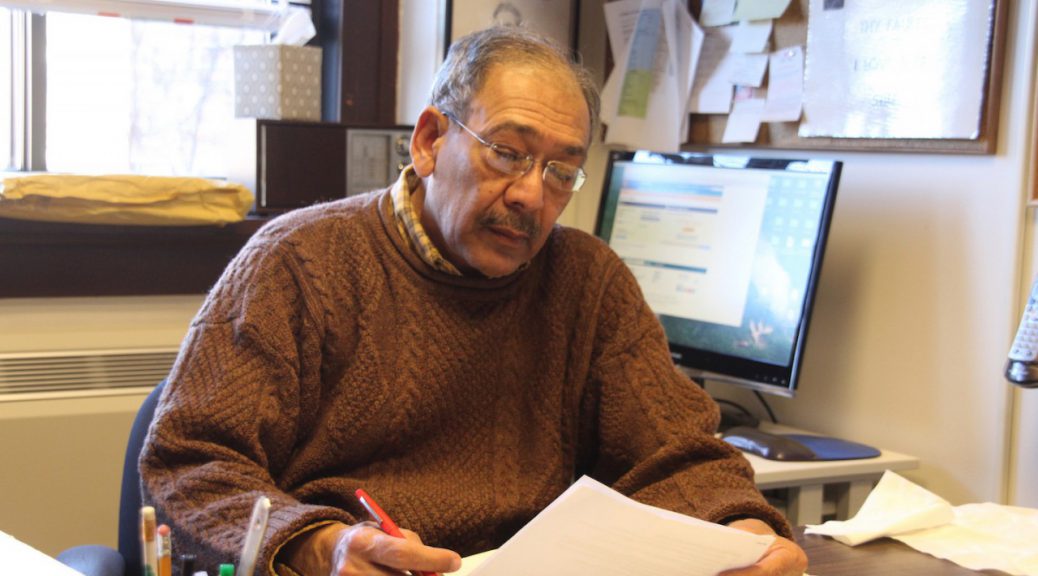By Michaela Gaffe and Sara Tiradossi
Winona State University has a long history, and there are professors currently on campus who can tell that history since they have taught at the university for many years.
According to Assistant Director of Human Resources Sandra Reed, the average length a professor will stay on campus is 12.2 years. The longest employed professor in history was Joseph Foegen, professor of business administration and management, who worked at Winona State from 1958 to 2009, and the current professor who has been at the university the longest is Marvin Wolfmeyer, professor of economics, who has taught since 1969.
Winona State was the first established normal school west of the Mississippi, founded in 1858. Since then, it has evolved into a nationally recognized university, with a mission “to enhance the intellectual, social, cultural and economic vitality of the people and communities we serve,” according to the university’s statement.
The joy of learning and sharing that knowledge with students brought Mark Young, professor of marketing, to Winona State, who decided to stay because he enjoys the campus, and thinks the community is a good place to work and live.
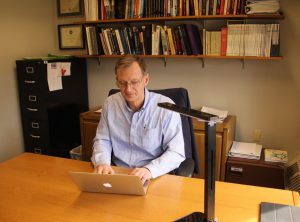
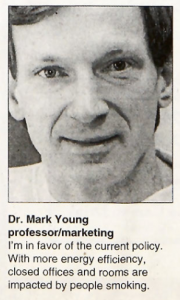
Young has worked at the university since 1980, starting when he was just 23 years old.
He recalled the time when the marketing department was on the third floor of Somsen Hall, with no air conditioning.
“We would have the windows open on a hot day, and a bee would fly in,” Young said. “Students would scramble.”
Since then, marketing has been moved to the first floor of Somsen. In addition to this change, Young remembers parking on the campus when there had been streets through campus instead of sidewalks. It was more of a downtown atmosphere, Young said.
“Physically the campus has changed a great deal, the buildings have been very significant,” Young said. “The library, the science engineering building and the wellness center, have shaped wheat we think of the campus and how we interact with the students and the campus.”
With a great facilities crew the grounds have improved, Young said, with the addition of trees and plants, and in his opinion, Winona State became one of the prettiest campuses in the country.
Besides the physical facilities changing, the technology has also changed, according to Young. Campus has gone from having a couple of computer lab rooms, and using punch cards for running computer programs, to now having laptops, iPads, phones; and technology has transformed how students learn, Young said.
With the evolution of technology, classrooms have become more interactive and less traditional-lecture style, Young said. For instance, the marketing classrooms no longer have desks that stare at the professor, but round tables.
“We now have a much diversified, very high quality faculty,” Young said. “We have a higher level quality of faculty that has more emphasis on staying current, active and engaged with students and with their disciplines.”
Community interaction has also changed since Young began at Winona State.
“When I first came, it seemed like the community thought of us as a sort of ivory tower,” Young said. “There was a lot of negative press with the student conduct back and forth downtown; and in those early years, there was talk about closing the university down.”
In 1982, Young did an economic study, on the impact of Winona State on the economy. Back then, it was a 59 million dollar impact, and once that was recognized, it reshaped the relationship between the community and the school.
The study showed how tied the university and the community are, and Young said relationship is not only economical but it also involves theatre, art and athletics. He sees that especially in the college of business, and its relationship with local businesses. An example of this would be the Wincraft Super Bowl Day, which exposed students to what the company has to offer. Fastenal Day is also approaching, which will bus students over to have tours, Young said.
“Almost every area has seen extremely positive changes,” Young said. “The environment is what you make it, but it provides opportunity to what you need to do.”
Young has had numerous opportunities to leave, but has not found anywhere he would prefer over Winona State.
“I am here because of choice. I think you would find that across the college, long tenure faculty. Once they come they enjoy it and stay,” he said.
Young finds motivation in helping students realize what their goals, dreams and ambitions are. He enjoys providing the encouragement, knowledge or reference to start them on the right track.
“After years of doing that, you start seeing some of that payback and their success. A lot of my students now are in the peak of their careers in upper level management positions, and impacting different companies,” he said. “There is that kind of intrinsic motivation of helping others but also what you get back as a faculty.”
Similarly to Young, John Vivian has been connected to Winona State for almost three decades. When Vivian first arrived at the university in 1982, there was not a journalism department, but there were journalism classes in the English department starting in 1966. He was the first chair of the mass communication department, which started in early 1980s by pulling courses from English and speech and borrowing faculty.
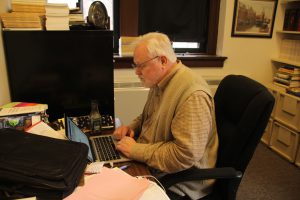
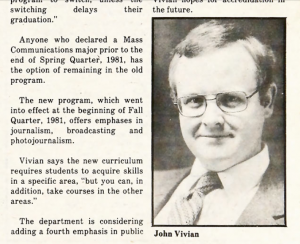
The university has seen some notable changes under various leadership, and some of them have been extraordinary, according to Vivian.
When he first started teaching, the first president who changed campus during his time was Tom Stark, Vivian said. The university faculty had run the previous president out of town and the administration was dealing with a new union, which caused a lot of tension. Tom Stark was chosen as president in 1983, and he had one goal: to make peace.
Vivian said Stark was good at that; he was a former superintendent. He was a horrible university president, though, who was smiley, a backslapper, and made people feel good, Vivian said.
Stark died in office of a heart attack while still fairly young. He achieved his goal and made the university more peaceable and faculty learned how to act together, Vivian said.
The next university president was Darrell Krueger, who was president for 14 years from 1989 to 2005. Krueger had a great sense of democracy and free expression, according to Vivian, and he let the university govern itself.
Krueger is the one who gave the university the motto, which has changed over the years to what it is now, “A Community of Learners Improving Our World.”
He fell asleep often, Vivian said. He fell asleep when Governor Jesse Ventura was on campus giving a speech and a photographer for the Winonan took a photo of him.
“He had some problems, perhaps narcolepsy. There was a story about him falling asleep while driving his car on Huff and Sarnia, and somebody had honked to wake him. Maybe he worked long hours and was tired,” Vivian said.
Krueger was good for the university, and Stark got the place settled down. The president after Krueger was Judith Ramaley, who was terrible, Vivian said. She arrived after being fired from the University of New Hampshire, because she cancelled the hockey season after the hockey coach lied to her about something, Vivian said, and they asked her to resign and she did.
“She was such an unpleasant human,” Vivian said. “She wanted to establish an academic stamp on the university, to make it more intellectually respectable. That is an insult to the community, we’ve always had some fine scholars here.”
Ramaley hated the press, she was a control freak, and she was snarley,Vivian said. She would go to conferences, as presidents do, and hired a limo to bring her to the airport at the university’s expense. Now there is a rule stating one cannot rent a limo using the university’s money, Vivian said.
The current president is Scott Olson who took over for Ramaley after she retired in 2012.
Vivian has a lot of respect for Olson because his stamp isn’t all over the place. Vivian said he listens, watches, and deals with crisis situations well. He puts his students first, and there is no covering up problems. If there is a problem, it is addressed; and he knows this well because he is a journalist, according to Vivian.
“The students focus on classes, but the quality of the university is very much a product of the leadership,” Vivian said.
Students keep Vivian motivated, and he enjoys keeping in touch with past students and seeing their achievements.
He never teaches a class the same way twice, because there is no perfect way. Vivian said some teaching styles work well with some students, and not well with others. Vivian’s teaching is fueled by his textbook writing, and one of his textbooks is going into its twelfth edition this month.
Before coming to Winona State, Vivian worked at the Associated Press and was tired of working odd shifts and hours.
One Thanksgiving evening he had friends over, and was confiding in them how unsure he was of continuing his current position at the AP. He then decided to pursue teaching. His first teaching role was at Marquette University, and he has not regretted teaching since. Vivian went to New Mexico State University to build a journalism program with a friend who was department chair. It never worked out, and he came to Winona State.
“Winona State is a high quality institution for its size and considering its roots as a teachers’ college,” Vivian said.
Vivian plans to stay here for the rest of his career.
“They’ll have to carry me out,” he said.
During the same year, Winona State welcomed another mass communications professor.
Originally from India, Daniel worked for an international radio station in Ethiopia and became acquainted with broadcasting before coming to the U.S. At the time, the company was shutting down and he had the choice of staying in Africa or studying in the U.S. for higher education.
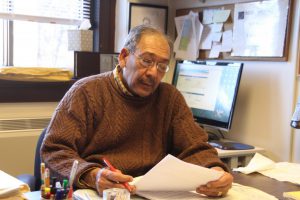
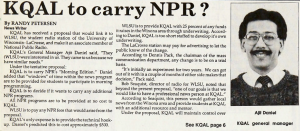
“I had always wanted to go to the U.S., even when I was a little boy. This was a good chance for me,” Daniel said.
In 1977, when he was 29, Daniel flew to the U.S. to start his college path at Southern Illinois University, where he stayed until 1981.
As an international student, he had to find a job right after graduation if he wanted to keep staying in the U.S. Daniel said when he was first applying for jobs, he was offered to teach at SIU for one year in the mass communication department.
Daniel said he was scared at first because he had never taught and thought he could not measure up to the other teachers. He was diffident but excited to have a possibility to stay in the country. When the other teachers showed their support and encouraged him to try to teach, Daniel decided to gratefully accept the offer.
After two semesters, Daniel said he had to start applying to other places because the position lasted one year only. He then applied to 47 universities and got six offers out of all the applications he had sent. The job offers were from universities in California, New York, South Dakota and other states, Daniel said.
“The one thing that made me want to come here is that Winona State gave me a chance to teach and manage a radio station also. That’s what attracted to me,” Daniel said.
In 1982, Daniel began his teaching journey at Winona State University and managed the KQAL radio station half the time and taught the other half in the department of mass communication. In 2008, Daniel switched to full time teaching.
When Daniel first started teaching at Winona State, the campus had a different appeal. Many structures were replaced and renovated. For instance, Daniel said there were tennis courts where the library is currently located and the library used to be in Maxwell Hall.
Daniel said the university population was 4,300 students in the 1980s, but the university knew there was a high need to grow. Because the university needed more space to fit more students, Daniel said, officials started buying more lands and homes and it expanded all the way to West campus, that used to be a residential college.
When technology was entering people’s lives, Daniel said he had to adapt his style of teaching consequently. Between 1991 and 1993, Daniel said, the departments became computer-oriented, which represented a big change from typewriters.
“It was hard. In those days, faculty did not know how to use the computers and had to learn everything from scratch,” Daniel said.
In 1992, Daniel bought his first desktop Macintosh, which sat in his house for eight months because he did not know how to use it. Little by little, he gained more knowledge on the use of computers and started applying the new resources in his classes.
“Once you start making mistakes, the rest is all history,” Daniel said.
Daniel is now a retiring professor who has taught general mass communication courses, from Mass Media theory to International broadcasting.
Not only did he adapt to technology changes, but he also had to mold himself with the times, as well as his thinking and perspectives. When it comes to teaching, Daniel said he has never compromised academic discipline through his career.
“Students should know when they come here that studying in a university is a privilege, not an entitlement,” Daniel said. “Every single student is important to me.”
Daniel said he tells students he believes in them and adopts a strict teaching style because to him, they do not represent students only, but they represent a piece of America’s future.
When students disagree at his thinking because their way of life is different than his, Daniel’s goal is always the same; bringing the students to a certain level of excellence. After 35 years of teaching, Daniel said students have kept him motivated to do his job.
“One day after students graduate, they will be part of this society. I can’t let them fail, because if I do so, I fail myself,” Daniel said. “I only want to be part of successes.”
Sometimes, Daniel said his position as a second language professor became challenging and he found himself in situations of disrespect from students and others.
When he was still a growing professor, he received complaints from two students who were involved with the national broadcasting society and quickly became his ‘enemies,’ he said. They approached the Dean and explained the problems they had with Daniel’s behavior as the advisor of the society.
Daniel said he showed his paper records and all the proof he could to demonstrate they were wrong. Throughout the conversation, the Dean said there was a problem of miscommunication and language barrier among them. Her response made Daniel feel disrespected, Daniel said, but he still maintained his position and said he had learned English as a second language, instead of simply picking it up, so she was not qualified to correct him.
“Abuse can knock you over but if you have confidence in yourself, you will make it through,” Daniel said.
Daniel said teaching can have its ups and downs, but it is also creative and it requires taking a big responsibility. Many times, students write back to him after they graduate and thank him.
“That’s my reward. If the students are honest with themselves, they will appreciate what I do,” Daniel said.
The professors all came with different motivations, backgrounds and experiences, but they all have similar reasons for staying at Winona State. Over the years, the university has gone through major changes, and professors like Young, Vivian and Daniel had to shape their teaching and methodologies to meet new demands. As they are retiring soon, new faculty will take their place and continue to shape the university.
